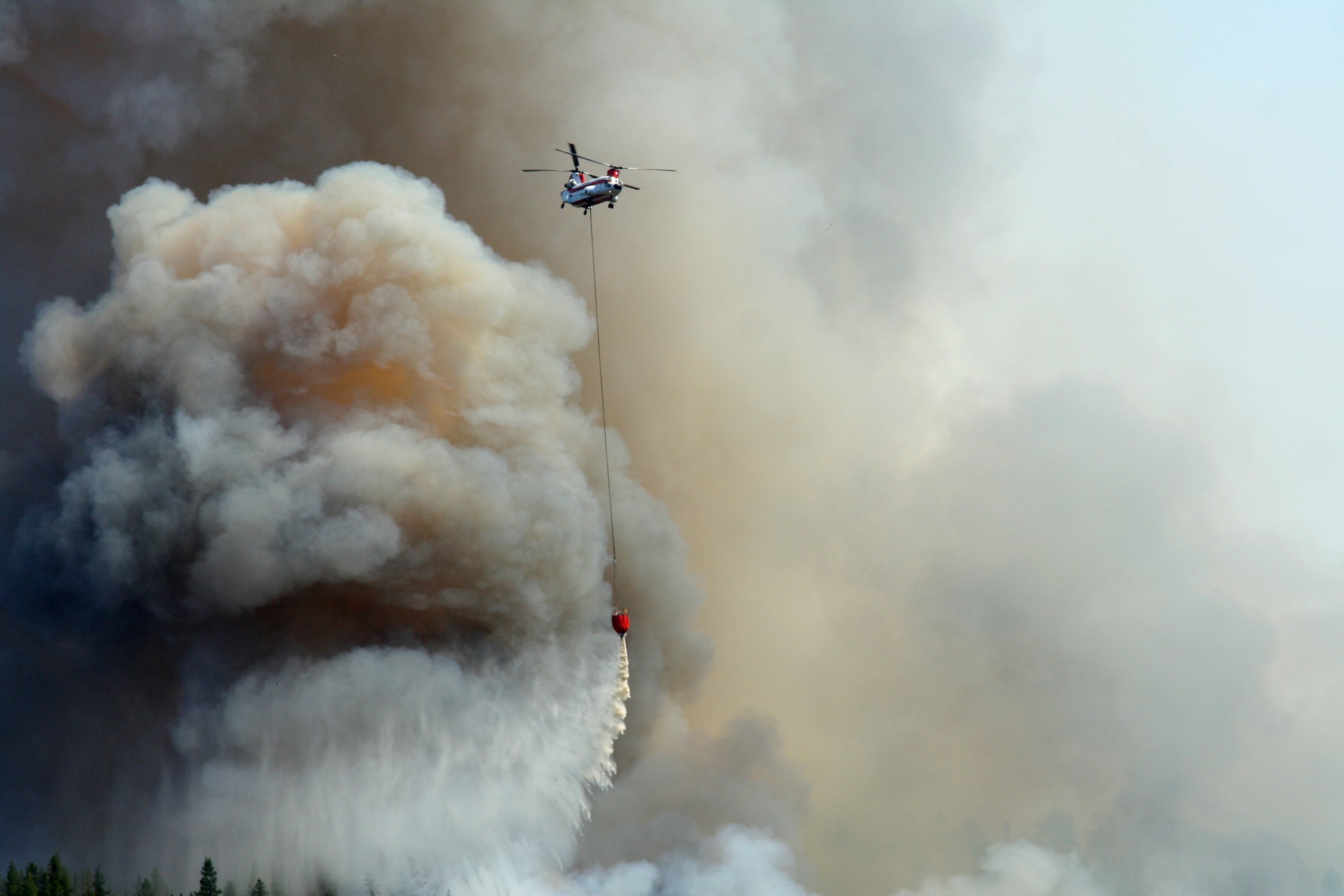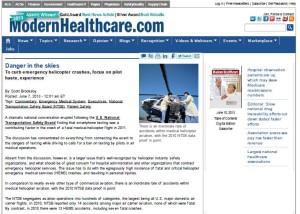The following was presented by Scott Brooksby at the ABA National Institute on Aviation Litigation in New York, New York, on June 4, 2015, concerning “Issues, Tips and New Technologies for the Emergency Medical Helicopter Case”:
Introduction
Why Are There So Many Helicopter Air Medical Crashes Causing Serious Injury or Death?
Prosecuting and defending helicopter crash cases is complicated and difficult. This is particularly true in the cases involving helicopter emergency services flights (“HEMS”). Pilot stress, fatigue, motivation to accept and accomplish a mission, weather conditions, including inadvertent encounters with Instrument Meteorological Conditions (IMC), varying unit technology, wide-ranging pilot training and flight time, differing qualities of dispatch decision making programs, all contribute to the complexity of HEMS flights, and the relative frequency of crashes related to HEMS flight.
According to the NTSB, which is charged with investigating every aviation accident in the United States, and many abroad, there were no fatalities in any 14 C.F.R.§ 121 accidents in 2010. This despite some 17.5 million flight hours. In 2011, there were 31 Part 121 accidents with no fatalities and 54 Part 135 accidents consisting of 16 fatal accidents and 41 fatalities. (Review of U.S. Civil Aviation Accidents, Calendar Year 2011, Review of Aircraft Accident Data NTSB/ARA014/01, PB2014-101453). This data excludes air medical operations conducted as part of general aviation.
Air medical operations are conducted under Parts 91 or 135 of Title 14 of the Code of Federal Regulations, depending on whether patients are being carried on board the aircraft. Helicopter Emergency Medical Services (“HEMS”) missions en route to collect patients, or to collect organs, or to reposition aircraft after accomplishing patient transport operations, are generally conducted under Part 91. Trips conducted to transport patients or organs on board are conducted under Part 135. Some air medical helicopter operations, particularly for emergency medical services, are conducted by state or local government entities as public use flights, whether patients are on board or not.
A Statistical Overview of HEMS Accident Frequency and Type
Six air medical accidents occurred in 2011, two of which were fatal. Id. From 2002 through 2011, 41 percent of air medical accidents involving fixed-wing airplanes and 36 percent of air medical accidents involving helicopters were fatal. Id.
HEMS accounted for about 80 percent of all air medical accidents during the ten-year period 2001-2011. Id. Against this backdrop, we examine medical accidents, specifically those involving helicopters, where in 2010 alone, there were 13 HEMS accidents, 7 of which were fatal. From 2002-2011, 42 of the 118 HEMS accidents (36%) were fatal. Id.
In 2011, there were three helicopters involved in air medical accidents in 2011. The first accident involved a helicopter operating under Part 91, which encountered abnormal runway contact during a power-off landing resulting in substantial damage to the aircraft, but no injuries. The second accident involved a helicopter operating under Part 135. Substantial damages occurred when it impacted terrain during an autorotation following loss of power and all four occupants were fatally injured. In the third accident, also operated under Part 135, a main rotor blade contacted the vertical stabilizer during engine shutdown, resulting in substantial damage but no injuries.
The pilots of these helicopters had an average total flight time of 11,935 hours, with an average of 1,355 hours in the type of accident aircraft. The accident pilots were an average of 53 years old. Id.
Six of the Seven HEMS fatalities in 2010 involved operations under Part 91. From 2000 through 2010, 33 percent of HEMS accidents were fatal. Most HEMS accidents occurred during airborne phases of flight and during 2010, all HEMS fatalities occurred during airborne phases of flight.
Between 2007 and 2009, air medical accidents were dominated by helicopters flying emergency medical service operations, rather than transfers of patients. EMS flights in helicopters, under Part 91 regulations without patients on board had substantially higher accident rates than any other category of air medical flying.
While fixed-wing airplanes are more often used for interfacility transportation using established airport facilities, there are few accidents. Between 2000 and 2009 there were few accidents and only 10 of them were fatal over the course of the decade. (Review of U.S. Civil Aviation Accidents, Review of Accident Data, 2007-2009, NTSB/ARA-11/01, PB2011-113050)
It may be useful to breakdown the 31 accidents involving 32 helicopters in air medical operations between 2007-2009. Eighteen were being operated under Part 91, thirteen under Part 135 and one as a public use flight. Eleven of the accidents, involving 12 helicopters were fatal. There was one public use fatal accident in 2008. Collision with objects on takeoff or landing accounted for 7 of the 31 accidents but no fatalities.
Four of the five controlled flight into terrain accidents were fatal, including the crash of the Maryland State Police public use flight carrying accident victims on approach to Andrews Air Force Base. Two of the three loss of control in-flight accidents were fatal, as were two of the three unintended flights into instrument meteorological conditions accidents. The midair collision between two Part 135 helicopters in Flagstaff, AZ in June 2008 was also fatal to all on board. All of the fatal accidents occurred during airborne phases, including en route, approach, maneuvering and emergency descent. Id.
What Are The Typical Causes?
In any aviation operation, pilot training and experience, and pilot judgment are some of the most important factors in safe flight. With helicopter operations generally, and especially HEMS operations, pilot experience, training and judgment are even more critical because of the conditions they fly in, and the unparalleled need for speed. Review of individual NTSB probably cause reports, NTSB factual data and other aviation industry data would tend to suggest that fatal and serious injury helicopter accidents are most often the result of a number of factors including loss of control, visibility issues, wire strikes, system component failure or post-impact fire.
Although some of these issues pose dangers during Part 121 operations, an argument could be made that they simply do not pose the same risks, largely due to obvious differences in the nature of the aviation operation, the equipment, altitude, avionics, take-off and landings from tightly controlled air-space and the use of aerodromes. Another significant factor may be that Part 91 operations have no duty time restrictions. (Special Investigation Report on Emergency Medical Services Operations, Aviation Special Investigation Report NTSB/SIR-06/01. PB 2006-917001, Notation 4402E, National Transportation Safety Board, January 25, 2006). Fatigue has been shown to impair performance and diminish alertness. (National Transportation Safety Board, Evaluation of U.S. Department of Transportation Efforts in the 1990s to Address Fatigue, Safety Report NTSB/SR-99/01 (Washington, DC: NTSB, 1999).
There is also wide variation in the nature and quantity of helicopter air medical pilot training. From 2007-2009, for example, NTSB data suggest that the accident helicopter pilots’ median age was 54, ranging from 35 to 69. Median total flight hours were 7,125 with a range from 2,685 to 18,000. The median time in the type of accident helicopter was 375 hours, ranging from 11 to 4,241. Id.
Review of any significant sample size from the NTSB aviation accident database shows that weather, particularly unanticipated entry into IMC, or pilot election to accept a mission with known adverse or deteriorating weather conditions is a major factor. (See, e.g, case studies in Special Investigation Report on Emergency Medical Services Operations, Aviation Special Investigation Report NTSB/SIR-06/01. PB 2006-917001, Notation 4402E, National Transportation Safety Board, January 25, 2006)(Stanislaw P.A. Stawicki, MD, Hoey, Brian A, MD, Portner, Marc, MD, Evidence Table: Summary of Aeromedical Incidents (2003-2012) OPUS 12 Scientist, 2013 Vol. 7, No. 1.
For example, on March 25, 2011, a Eurocopter AS350B3, registered to Memphis Medical Air Center crashed while heading directly into a weather cell, killing the pilot and two flight nurses. The NTSB ruled that attempting to fly into adverse weather, with localized adverse night IMC, was the likely cause of the crash. The shift pilot suggested parking the helicopter, but the active duty pilot insisted there was enough time to make it, believing he had about 18 minutes to beat the storm and return to base. The shift pilot later learned the flight was about 30 seconds from arrival when the helicopter crashed. Similar scenarios involving poor judgment, adverse weather conditions, and lack of outside, objective input on whether a mission should proceed are frequent NTSB probable cause factors. Id.
Statistics suggest that such variations in flight time and the corollary impact on experience and judgment may be significant factors in the number of crashes. Id. HEMS operations often make use of helicopters, and they use unimproved landing sites at accident scenes and helipads and hospitals or medical facilities.
Loss of control in flight was the most common event for both fatal and non-fatal helicopter crashes, followed by collisions on takeoff or landing and system component failure of the power plant. Even though HEMS pilots may have thousands of flight hours, and be some of the best helicopter pilots in the world, owners and operators should continuously emphasize the consistent causes of HEMS crashes and adapt training programs to focus on those causes.
Possible Improvements
One of the NTSB’s “Most Wanted” Transportation Safety Improvements in 2015 is the enhancement of public helicopter safety. However, many of these suggestions could apply to non-public use helicopter activities under Part 135 or Part 91. http://www.ntsb.gov/safety/mwl/Pages/default.aspx (Last visited April 2, 2015).
Since 2004, the NTSB has investigated more than 130 accidents involving federal, state, and local public helicopter operations, including the 4 mentioned above. Fifty people were fatally injured and 40 seriously injured. Id. What can be done:
- Operational factors including the development and implementation of safety management systems hold great promise. In particular, flight risk evaluation programs and formalized dispatch and flight-following procedures which relieve pilots of decision making under stressful or fatiguing conditions. Also promising, are scenario-based training which exposes pilots to inadvertent flight into IMC.
- Investment can be made in advanced technologies. The NTSB has recommended that helicopter operators install radio altimeters, night vision imaging systems and terrain awareness warning systems.
- Finally, the NTSB advocates for crash-resistant flight recorder systems for all aircraft.
Although these items are on the NTSB’s Wish List for 2015, at least as to the enhancement of safety involving public use helicopters, a 2006 NTSB report discusses what are essentially the same improvements as recommended for air medical services. (Special Investigation Report on Emergency Medical Services Operations, Aviation Special Investigation Report NTSB/SIR-06/01. PB 2006-917001, Notation 4402E, National Transportation Safety Board, January 25, 2006). While valuable safety improvements have been recognized for some time, they may not be as actively implemented as necessary.
Case Notes
In what may be one of the first cases of texting and flying, a helicopter emergency medical services flight case involving pilot texting was settled in April, 2013. The NTSB conducted a public hearing and concluded the pilot sent and received 240 text messages during his shift, including three sent and five received while the helicopter was in flight. The distracted pilot failed to realize that he had inadequate fuel to complete the flight, which crashed near Mosby, Missouri on August 26, 2011 due to fuel starvation. The case is Bever, et al. v. Estate of Freudenberg, Clay County, 11Cy-10505, Tacoronte, et al. v. Estate of Freudenberg, Clay County, 11CY-CV10179. The case was settled for a reputed $8,000,000.
On September 27, 2008, “Trooper 2,” a HEMS flight operated by the Maryland State Police, crashed several miles short of the runway at Andrews Air Force Base while executing an ILS approach with two motor vehicle accident victims on board. The accident killed the pilot, the Maryland State Police paramedic, a borrowed paramedic from the landing site, and one of the two MVA victims. The other MVA victim—the sole survivor—was thrown from the wreckage at impact and suffered severe injuries. Despite the fact that the helicopter had received radar vectors onto the final approach course and was equipped with ADS-B (which provides position data every second), the survivor languished in a pond of Jet-A at night for two hours before being found. The United States was joined in the subsequent litigation, and all cases ultimately were settled by Maryland and the United States for approximately $15,000,000.
The NTSB recently published its report on an accident near Talkeetna, Alaska, on March 30, 2013, in which a Eurocopter AS350 B3 helicopter,1 N911AA, impacted terrain while maneuvering during a search and rescue (SAR) flight. See NTSB/AAR-14/03 (November 14, 2014). The airline transport pilot, an Alaska state trooper serving as a flight observer for the pilot, and a stranded snowmobiler who had requested rescue were killed, and the helicopter was destroyed by impact and postcrash fire. The helicopter was registered to and operated by the Alaska Department of Public Safety (DPS) as a public aircraft operations flight under 14 Code of Federal Regulations (CFR) Part 91. Instrument meteorological conditions (IMC) prevailed in the area at the time of the accident. The flight originated at 2313 from a frozen pond near the snowmobiler’s rescue location and was destined for an off-airport location about 16 mi south. The NTSB determined the probable cause of the accident was the pilot’s decision to continue flight under visual flight rules into deteriorating weather conditions, which resulted in the pilot’s spatial disorientation and loss of control. Also causal was the Alaska Department of Public Safety’s punitive culture and inadequate safety management, which prevented the organization from identifying and correcting latent deficiencies in risk management and pilot training. Contributing to the accident was the pilot’s exceptionally high motivation to complete search and rescue missions, which increased his risk tolerance and adversely affected his decision-making.



